

Home/Active Page
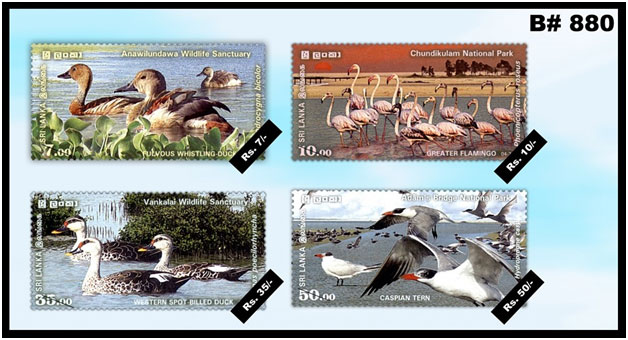
| Date of Issue: | 2nd February 2016 |
| Denomination: | Rs.7.00, Rs.10.00, Rs.35.00, Rs.50.00 |
| Catalogue No. | Rs.7.00 - CSL 2144 |
| Stamp Designer: | Mr. D.G Sudath Jayawardhana |
| Sheet Composition: | 20 stamps per sheet |
The Philatelic Bureau of the Department of Posts issued four new postage stamps with four souvenir sheets in the denominations of Rs.7.00, Rs.10.00, Rs.35.00 andRs.50.00 depicting the sceneries of AnawilundawaWildlife Sanctuary,Chundikulam National Park, Vankalai Wildlife Sanctuary and Adam's Bridge MarineNational Park to commemorate the World Wetlands Day 2016.
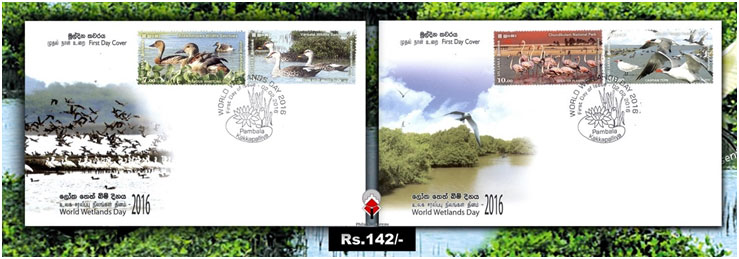
Wetlands arereferred to as habitats with permanent or temporary accumulation of water with associated floral and faunal communities. Sri Lanka has a geography which supports the formation of wetlands to a great extent. Due to diverse geographical settings, wetlands of different areas display different characteristics. There are 3 broad categories of wetlands found in the country namely:
The interaction between soil, water, plants and animals in the wetlands enable many functions which are useful to people as well as the entire eco-system. Sri Lanka is a mesmerizing destination for bird watching. However, the wetlands in the country beside the others are among the best places to observe Sri Lanka’s avifauna.
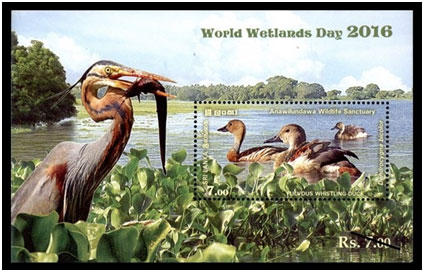
Anawilundawa WildlifeSanctuary is located in the Puttalam district, the northwestern part of the island, about 100 km away from Colombo. The area stretches 1,397. 037 hectares and is well-known amongst bird lovers. Anawilundawa, wasdeclared a Wildlife Sanctuary by the Department of Wild Life Conservation on11th June 1997.
The area an excellent locale for birds to breed and overwinterhas the three totally different eco-systems that converge there. Brackish water wetlands with salty marshland, water gardens complemented by a freshwater system of man-made tanks and canalsbuilt in the 12th century, the adjoining costal area with its sand dunes and beaches arethe threeeco-system creating the bird paradise.
Anawiludawa is home to more than 150 different types of birds. The domestic species are in the sanctuary throughout the year. To observe the migratory birds, October to April is the best time to visit. Open Bill, Purple Coot, Common Moorhen, Lesser Whistling Teal, Purple Heron, Grey Heron, Stork-billed, Common, Pied & White-breasted Kingfishers, Gargeni, White-Billed Sea Eagle, Grey-headed Fish Eagle, Black-Winged Stilt, Cotton Teal, Indian Shag, Spoonbill, Large, Median & Little Egrets, Black-backed Yellow Woodpecker, Brown Fish Owl and many more can be seen in the area.
Fulvous Whistling – Duck shown in the stamp iscommon in the area and similar to Lesser Whistling Duck, but a darker brownish-red with a black cap. Black extends down along nape. Rump, upper tail covert and under-tail covert whitish. Flank cream striped. They live in small flocks and they are night feeders. During day they roost besides water bodies.
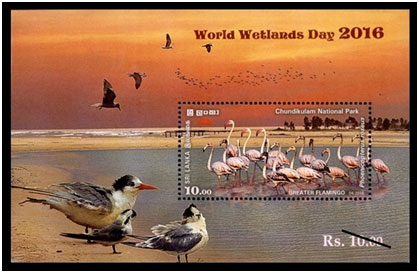
The thin stem of land connecting mainland Sri Lanka and the northern peninsular, bordered by the Indian Ocean from the east and carving to create a lagoon from the west is adivine hotspot of wild creatures. As a result of this rich bio-diversity the ChundikulamLagoon and surrounding area was declared a Wildlife Sanctuary in 1938.It was upgraded to a National Park on 22nd June 2015.
Chundikulam National Park belongs to 3 districtsin theNorthern Province, Killinochchi, Mullaitivu and Jaffna. It stretches 1965.33 hectares and lying off the northern coastal area. From beaches laden with sand-dunes, to salt marshes, to wetlands, to thorny scrublands and dry forests, to tanks, mangroves and thelagoon have all combined to produce wetland habitats within the park.This wetland areaover flow with aquatic birds such as Painted Storks, Pelicans, Godwits, Ducks, Open Bills, Spoon Bills, Ibis, and many species of waders that scoop their beaks in a tireless effort in search of food.
During the migratory season, spanning from November to Februarythe park becomes the major site of activity for large flocks of birds, such as Terns and Gulls, and to raptors such as Kites and Sea Eagles.
TheFlock of Greater Flamingos shown on the stamp is the picturesque sceneatthe Chundikulam Lagoon during the migratory season. White plumage suffused with pink and scarlet. Black primaries and outer secondaries. Upper and underwing coverts rose pink to bright scarlet. Long pinkish – red legs. Bill bent downwards from approximately mid-point. They arepresent in large flocks.
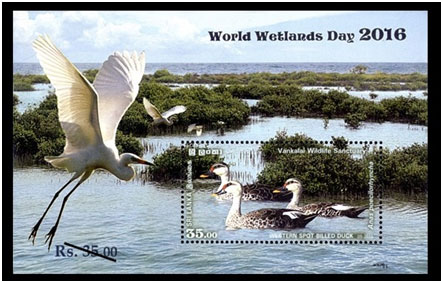
Vankalai was declared as aWildlife Sanctuary on 9th September 2008 and is located in the Mannar district. The Vankalai Sanctuary consisting of around 4838 hectares was declared as a RAMSAR site on 12th July 2010 and is the fourth Ramsar wetland in the country. This has become an important habitat and breeding ground for some migratory birds. Over a 1000 migratory bird species and around 150 resident bird species have been recorded in the sanctuary.
This sanctuary, partly a Wetland, comprises Puliyantivuisland, Tiruketiswaram, Pallimunai, Vankalai and the strips of land on either side of the causeway connecting the island of Mannar to the mainland. Covering about 4,800 hectares, it consists of arid-zone thorn scrubland and pastures, waterholes and tanks, sand dunes, mangroves, salt marshes, lagoons and sea-grass beds and maritime grasslands
The Vankalai bird sanctuary has been an important habitat for migratory birds, water fowls and ducks for a long time. When migratory birds arrive in Sri Lanka from the Arctic Tundra they make a land fall in this area. They use this area for feeding and resting. Migrant birds are found in large numbers at this bird sanctuary every year.
Many very rare migrant bird such as the Spot-billed Duck, the Comb Duck and the Gadwall; the rare migrant Long-toed Stint and the uncommon migrants the Peregrine Falcon, the Common-ringed Plover, Temminck’s Stint and the Red-necked Phalarope have been spotted at Vankalai.
Western Spot – Billed Duck shown in the stamp is arare migrant in the area. Blackish plumage. Pale head and neck. Blackish cap. Feet red. Dark eye line and moustachial streak. Bill black with yellow tip and red spot at base. Female: Mottled dark brown with paler head and neck. Dark line through eye.
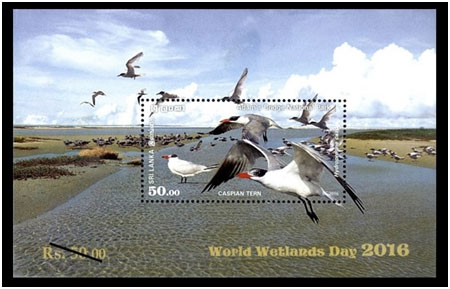
The Indian Sanskrit epic Ramayana by Valmiki speaks of a bridge, Setubandhanam, a bridge over the ocean connecting India with Sri Lanka. The thirty km long bridge, which separates the Gulf of Mannar from the Palk Strait, was reportedly passable on foot up to the 15th century until storms deepened the channel. The Rameshwaram temple records suggest that Rama’s Bridge was completely above sea level until it was destroyed in a cyclone in AD 1480. Today it iscalled Adam’s Bridge, comprising103 small patch reefs lying in a linear pattern with reef crest, sand cays (accumulations of loose coral sands and beach rock) and intermittent deep channels.
Due to theshallowness of the sea in the area, the maritime bio diversity lies ata very high level. Marine mammals such as Dolphins,Whales and Dugong can be seen in this area. The diversity of fish is also very high .This region is rich with sea grass lands and the eggs and chicks can be seen lying on some spots on the sand dunes when exploring this area. This highly rich bio-diversity area of 18,990 hectares wasdeclared as a Marine National Park on 22nd June 2015.
The western boundary of this National Park is themaritime boarder of the India and Sri Lanka. The area of Adam’s Bridge belonging to India was nominated as a National Park by the Government of India. It is called the Gulf of Mannar National Park. Thus, the Adam’s Bridge Marine National Park is the only Trans Boundary National Park in Sri Lanka.
Caspian Tern shown in the stamp iscommon in the area and has Pearl – grey upper plumage, large red bill-often with yellow tip, shallow frok tail and back feet.
All rights received. All right to identify the Department of Posts as the Author and designer of this Bulleting has been asserted in accordance with the Copyright, Design and Patents Act 1988.No part to this publication may be reproduced, stored in or introduced into a retrieval system, or transmitted in any form or by and means (electronic, mechanical, photocopying, recording or otherwise) without the prior permission from the publisher. Any person who does and unauthorized act in relation to this publication may be liable to criminal prosecution and civil claims for damages.